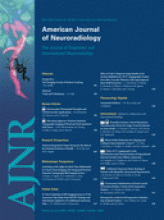Research ArticlePediatricsE
A Novel Association between RASA1 Mutations and Spinal Arteriovenous Anomalies
R. Thiex, J.B. Mulliken, N. Revencu, L.M. Boon, P.E. Burrows, M. Cordisco, Y. Dwight, E.R. Smith, M. Vikkula and D.B. Orbach
American Journal of Neuroradiology April 2010, 31 (4) 775-779; DOI: https://doi.org/10.3174/ajnr.A1907
R. Thiex
J.B. Mulliken
N. Revencu
L.M. Boon
P.E. Burrows
M. Cordisco
Y. Dwight
E.R. Smith
M. Vikkula

References
- 1.↵
- Eerola I,
- Boon LM,
- Mulliken JB,
- et al
- 2.↵
- Boon LM,
- Mulliken JB,
- Vikkula M
- 3.↵
- 4.↵
- Lapinski PE,
- Bauler TJ,
- Brown EJ,
- et al
- 5.↵
- Limaye N,
- Boon LM,
- Vikkula M
- 6.↵
- 7.↵
- Jacobs AH,
- Walton RG
- 8.↵
- van der Horst CM,
- van Eijk TGJ,
- de Borgie CA
- 9.↵
- Revencu N,
- Boon LM,
- Mulliken JB,
- et al
- 10.↵
- Mandzia JL,
- terBrugge KG,
- Faughnan ME,
- et al
- 11.↵
- Terdjman P,
- Aicardi J,
- Sainte-Rose C,
- et al
- 12.↵
- Uram M,
- Zubillaga C
- 13.↵
- 14.↵
- 15.↵
- Enjolras O,
- Boukobza M,
- Jdid R
- 16.↵
- Doppman JL,
- Wirth FP Jr.,
- Di Chiro G,
- et al
- 17.↵
- 18.↵
- Guggisberg D,
- Hadj-Rabia S,
- Viney C,
- et al
- 19.↵
- Kadoya C,
- Momota Y,
- Ikegami Y,
- et al
- 20.↵
- 21.↵
- Rodesch G,
- Hurth M,
- Alvarez H,
- et al
- 22.↵
- Shovlin CL,
- Guttmacher AE,
- Buscarini E,
- et al
- 23.↵
In this issue
Advertisement
R. Thiex, J.B. Mulliken, N. Revencu, L.M. Boon, P.E. Burrows, M. Cordisco, Y. Dwight, E.R. Smith, M. Vikkula, D.B. Orbach
A Novel Association between RASA1 Mutations and Spinal Arteriovenous Anomalies
American Journal of Neuroradiology Apr 2010, 31 (4) 775-779; DOI: 10.3174/ajnr.A1907
0 Responses
Jump to section
Related Articles
- No related articles found.
Cited By...
This article has not yet been cited by articles in journals that are participating in Crossref Cited-by Linking.
More in this TOC Section
Similar Articles
Advertisement











